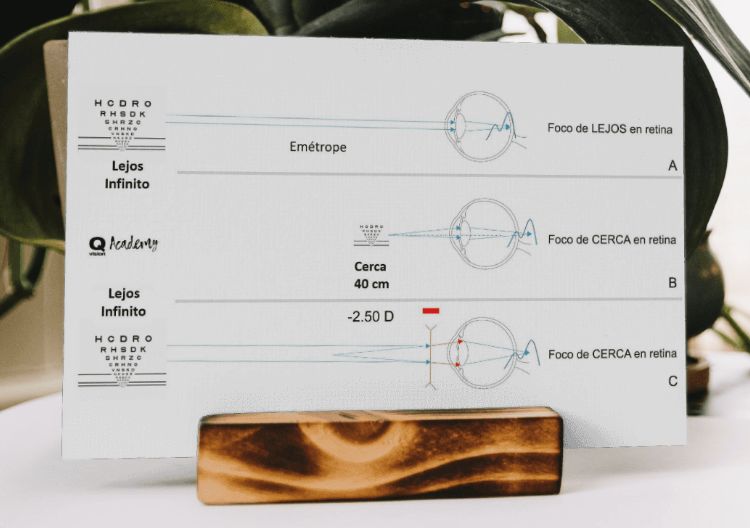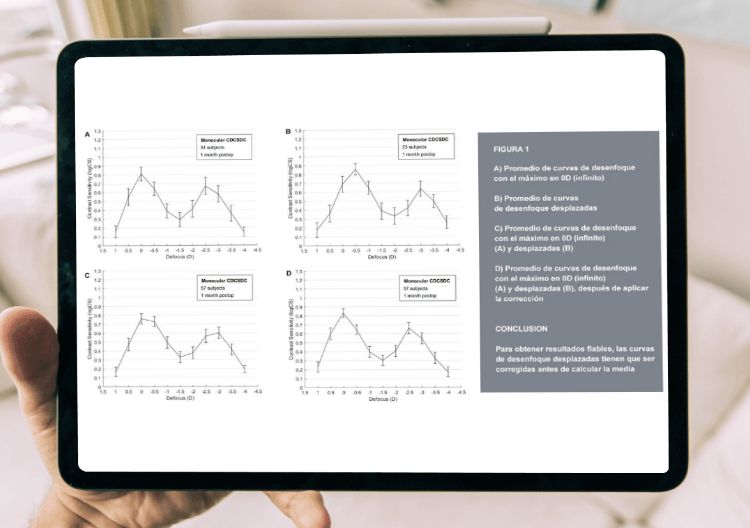It is important to take into account that changing optotype size is not the same that correcting vergence by proximal distance. This is a concept that generates confusion as we have seen in many of the courses we have conducted about Defocus Curves. The question we are asked is:
If my optotype is already calibrated for my cabinet distance, why do I have to put in a lens when doing the Defocus Curve?
Considering that the far point of the emmetropic patient is at infinity when we approach the test at 6 m, we are inducing a myopia of -0.1667 D. In other words, a patient refracted at 6 m and from whose refraction we obtain 0 D, may not really be emmetropic but myopic of -0.1667 D (1/-6). This is generally not clinically relevant because we measure the refraction in steps of 0.25 D or even the depth of focus might compensate for this small error.
What happens if I do the refraction and the defocus curve at 6 meters?
If we refract the patient at 6 meters and make the curve at 6 meters with that refraction and without correcting the (-0.17 D) with (+0.17 D) in theory our desired defocus curve in steps of 0.5 D from +1.00 D to -4.00 D would not describe the following dioptric values or distances:
| Defocus: |
+1.00 |
+0.50 |
0 |
-0.50 |
-1.00 |
-1.50 |
-2.00 |
-2.50 |
-3.00 |
-3.50 |
-4.00 |
| Distances: |
Inf |
Inf |
Inf |
-2 |
-1 |
-0.67 |
-0.50 |
-0.40 |
-0.33 |
-0.29 |
-0.25 |
It should be considered that the proximal distance generates a myopia of -0.17 D and that the exact defocuses we are measuring or distances would be:
| Defocus: |
+0.83 |
+0.33 |
-0.17 |
-0.67 |
-1.17 |
-1.67 |
-2.17 |
-2.67 |
-3.17 |
-3.67 |
-4.17 |
| Distances: |
1.20 |
3.00 |
-6 |
-1.50 |
-0.86 |
-0.60 |
-0.46 |
-0.38 |
-0.32 |
-0.27 |
-0.24 |
What is our recommendation?
Why make approximations when we can optimize our clinical procedure? Our recommendation is to refract at 4 m (for cabinets >= 4 m) or 2 m (for cabinets < 4 m). Emphasizing the following considerations:
- The refraction obtained will not be subjective at infinity but at 4 m or 2 m.
- To calculate the refraction with spectacles of the patient (Rx at infinity) we have to add -0.50 D of Sphere (if we have refracted at 2 m) or -0.25 D (if we have refracted at 4 m).
- If we start from the refraction at infinity we will have to use the vergence correction lens of +0.25 D (MLA at 4 m) or +0.50 D (MLA at 2 m).
- The MLA automatically integrates the values of these lenses with the Rx and the defocus lens to avoid lens build-up. You can learn more about this process in our article Preparing the lenses to measure a Defocus Curve
- If you use the MLA you can rely on the VisionC test during the refraction process. This App calibrates the ETDRS optotype chart for any desired distance from 4 m to 20 cm in order to perform the refraction at 2 m or 4 m or to measure the high and low contrast Visual Acuity at multiple distances.
Key Points:
- One should not confuse the size calibration of the optotype (which adjusts its size for the distance at which it is presented in order for the visual acuity notation to be correct) with the compensation for proximal vergence.
- When making a defocus curve at 6 m, without correction of vergence for proximal distance of -0.17 D with a lens of +0.17 D, the steps of defocus measured in theory do not correspond to those commonly used in defocus curve graphs, although it is true that most of the time the error is negligible because it is so small.
- When performing a defocus curve, one should refract at 2m or 4m, the refraction at infinity will be calculated by adding (-0.50 D) or (-0.25 D), respectively. If we start from the refraction at infinity and put the MLA at either of these two distances, we should add a (+0.50 D) or (+0.25 D) to the refraction at infinity to correct the vergence for proximal distance. This step is automatically carried out by the application.



